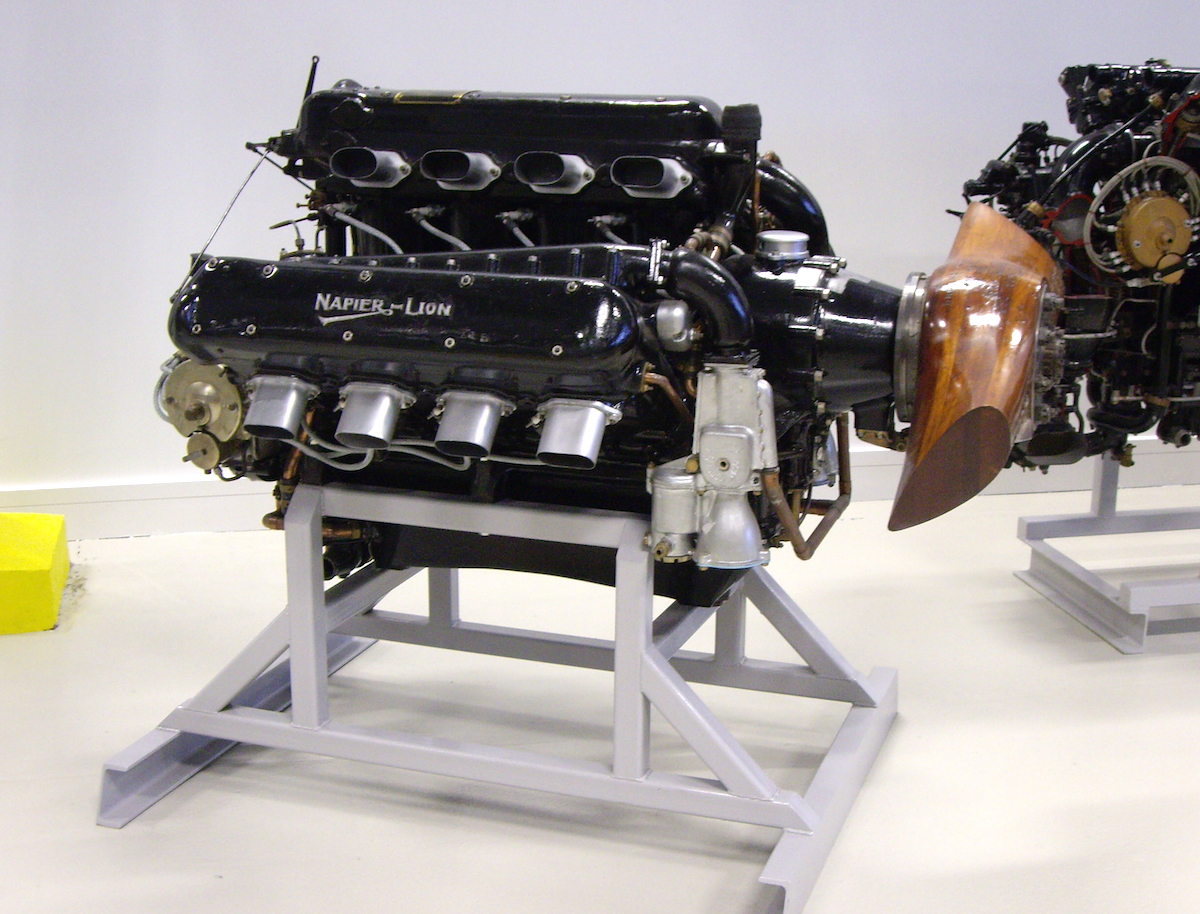Napier Aero Engines Introduction
Piston Engines
Montague Napier pioneered early vehicle engines, being the first in 1903 to produce a 6-cylinder engine. The company also supplied a Napier petrol-engine for a dirigible balloon design dated 1902. After the outbreak of WW1 the Government placed contracts on DNS for two Aero engine designs being the RAE 4-cylinder and Sunbeam Arab. Montague considered both engines to be inferior so he started work on a private venture which was to become the Napier Lion.
The “Napier Lion“, the world’s first broad arrow engine design, first saw use in 1918 as an advanced 24 litre 12-cylinder “Lion II” broad arrow engine of 450 bhp. The engine was constructed largely from aluminium alloy as a water cooled, double overhead camshaft engine with 4 valves per 2 litre cylinder. It was progressively developed over the following 20 years during which it powered over 150 aircraft types, both civil and military worldwide. For example the Fairey III D and F aircraft types served the RAF and RN squadrons for bombing torpedo and reconnaissance duties between 1920 and 1935. Squadrons of Vickers “Virginia, Vernon and Victoria” heavy aircraft provided military transport in many parts of the globe.
In early 1920’s the Government of the day had a requirement for a 1,000hp engine. D. Napier & Son produced their “Napier Cub” design. This had a “X” configuration and was succesfully test flown in a bomber before it was then decided that multi engines were better in large aircraft than one, so the project was dropped.
Powering the Schneider Trophy winners for Great Britain in 1922 and 1927 Napier developed the “Lion” engine design from 500 bhp in the Supermarine “Sealion” flying boat to 900 bhp output for the Supermarine “S5” seaplane which reached 281.6 mph. When supercharged to give 1350 bhp, the aero “Lion” briefly took the world air-speed record in 1929 in the lovely Gloster VI “Golden Arrow” floatplane at 336mph.
In 1931 a small 6-cylinder in line air-cooled engine, the “Javelin“, was produced and fitted in a number of light aircraft. These included the Percival Gull, Sparten Arrow, Martin Baker MB1 and the Commonwealth Wackett twin engine aircraft.
In 1933 Napiers produced the Jumo 204 engine under licence as the the “Culverin“. This was a 6-cylinder opposed piston liquid cooled engine and was successfully flown in a Blackburn Iris flying boat. A smaller version based on the Jumo 205, the “Cutlass“, reached the design stage only and was never produced.
Always innovative in its aero engine designs Napiers, now through the work of Major Frank Halford, produced a series of three “H” configured engines from 1930 which all differed in their 4-stroke valve design. The 16-cylinder “Rapier” of 390 bhp had push rod operated overhead valves, the 24-cylinder “Dagger” of 1,000 bhp had double overhead cam valves, whilst the 24-cylinder water cooled “Napier Sabre” was developed to 3,000 bhp with skew gear driven sleeve valves. This engine powered the fast “Typhoon” and “Tempest” fighter bombers of WW2 seeing their zenith in the D-Day offensive as well as in defence against the “V1” flying bombs at home.
Gas Turbines & Rockets
Post-war Napier commenced work developing gas-turbine engines commencing with their “Nymph“, “Oryx” and “Naiad” designs. However it was in powering gas-turbine helicopters that Napier took the lead in powering the RAF Bristol “Belvedere” twin rotor machine with 2 free-turbine “Gazelle” engines. Then there was the Westland “Wessex” series for the RN anti-submarine and air-sea rescue squadrons. The “Napier Eland” was a successful turbo-prop design exported and used in Convair aircraft. Furthermore two special 3,500 bhp “Elands” powered the unique 44 seat “Fairey Rotodyne” which took the helicopter speed record in 1957. The same year a double “Napier Scorpion” liquid-fuel rocket booster engine was tested in a “Canberra” bomber which attained the world altitude record at 70,300 feet. Other rocket motor and ramjet development work was carried out at the Napier Luton Flight Development Department. The Company also developed the “Napier Nomad” compound engine design which had a miserly fuel consumption making it ideal for use in the Avro Shackleton aircraft. Unfortunately mid-1950’s government policy saw all these designs (with the exception of the Gazelle) disappearing when all aero engine manufacturers were either closed or merged with Rolls-Royce.
For convenience we have split the Napier Range of Aero Engines can be split into three sections. Please follow the links below to read the history of Napier’s diverse and interesting aero engine designs.


